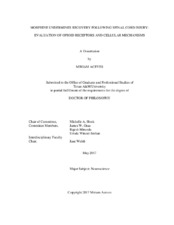| dc.description.abstract | Opioids are amongst the most effective and widely prescribed medications for the treatment of pain following spinal cord injury (SCI). Spinally-injured patients receive opioids shortly upon arrival at the emergency room, and prolonged opioid regimens are often employed for the management of post-SCI chronic pain. However, despite their utility, questions remain regarding the safety of these analgesics in the clinical setting. Indeed, previous studies in our laboratory suggest that the effects of opioids, such as morphine, may be altered in the pathophysiological context of neurotrauma. Specifically, our studies suggest that morphine use is contraindicated in the early phase of SCI. In our rodent model of SCI, acute morphine treatment increases tissue loss at the injury site, increases mortality, undermines weight gain and reduces recovery of motor and sensory function even weeks after treatment. The literature also suggests that opioids may exacerbate secondary injury mechanisms following SCI, increasing neurotoxicity at the lesion site. Based on these data, it would be tempting to suggest that morphine be eliminated as an analgesic after SCI. However, as pain is one of the most debilitating consequences of SCI, we cannot afford to simply remove a potential analgesic therapy. To address this, the experiments presented here examined the molecular mechanisms underlying the adverse effects of morphine. The first set of experiments evaluated classic opioid receptor signaling and showed that the κ-opioid receptor (KOR) system significantly contributes to the morphine-induced attenuation of function following SCI. The second set of experiments showed that, while non-classic opioid receptor signaling is not sufficient, glial activation is critical to morphine’s adverse effects. The last set of experiments investigated the effects of acute morphine treatment on the cellular environment of the lesion site. The findings suggest that opioid-immune interactions following SCI – mediated by the KOR system – may exacerbate secondary injury mechanisms, leading to increased cell death and attenuated recovery of function. Together, the results presented here underscore the need to improve the safety and efficacy of opioids in the clinical setting. | en |


